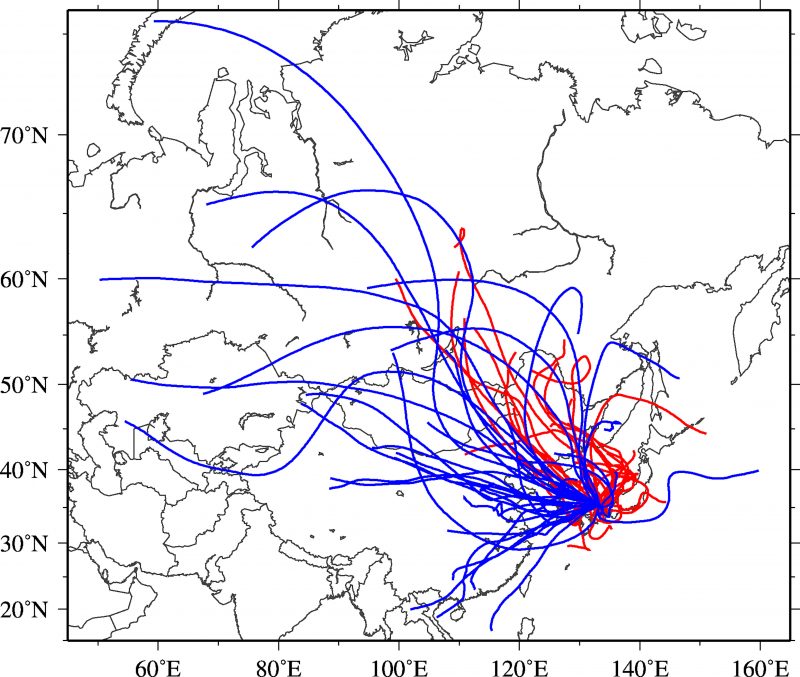22 April 2019
Microbes hitch a ride on high-flying dust
Posted by larryohanlon
High-altitude dust may disperse bacterial and fungal pathogens for thousands of miles, seeding far-flung ecosystems and potentially impacting human health
By Mary Caperton Morton
Dust doesn’t just accumulate under your bed. It can also travel for thousands of kilometers, across continents and oceans.
A new study analyzed the microbial content of dust particles being transported from the deserts of central Asia to South Korea and Japan. The new research shows dust’s potential for carrying potential pathogens to far-flung places, potentially impacting natural ecosystems and human health.
Tucked in the rain shadow of the Tibetan plateau, central Asia is home to the sprawling Gobi and Taklimakan deserts. During the spring, summer, and fall, steady winds blow the top layers of sandy soil east, along with any microbes, such as bacteria and fungi, living on the surface. These winds disperse the particles over eastern Asia, Japan and across the Pacific.
Long-range transport of dust particles has been tracked for decades using satellites, but scientists had not looked at what types of microbes they could be carrying.
The new study, published in AGU’s Journal of Geophysical Research: Atmospheres, collected dust samples from South Korea and Japan, and used DNA sequencing to detect the presence of hitchhiking pathogenic bacterial species.

Red and blue lines show the trajectories of dust particles from the deserts of central Asia to the island of Japan. Red trajectories are dust particles that arrived to Yonago, Japan, at altitudes of 1,000 meters.. Blue trajectories arrived at 3,000 meters. The paths are calculated using the National Oceanic and Atmospheric Administration Hybrid Single Particle Lagrangian Integrated Trajectory model (http://www.arl.noaa.gov/HYSPLIT.php).
The new study finds some dust events were transporting as many as 400 different species of bacteria, including some potentially harmful to human health, such as Staphylococcus and Bacillus species.
“Our data shows that dust mineral particles include the nucleotide fragments of pathogenic species,” said lead author Teruya Maki of Kanazawa University in Japan. “Additionally, we have demonstrated that the fungi associated with dust events can enhance allergen levels by as much as 10 times [above baseline allergen levels].” The transport of bacteria such as Staphylococcus and Bacillus species could also lead to disease outbreaks in new human populations, he said.
The team is the first to demonstrate the long-range transport of dust-associated microbes at high altitudes using a unique system of helicopter and balloon sampling methods, Maki said.
Along with sampling the dust using helicopters and balloons, the team also relied on two continuous monitoring stations installed on 10-meter high platforms for four months of the 2015 dust season. The stations were situated downwind of Asian-dust source region in Yongin, South Korea and Yonago, Japan that fall along the main Asian dust transport trajectory.
After collecting the samples, the team used fluorescent microscopic observation techniques to identify dust, biological particles and pollutants such as black carbon. They then extracted and sequenced short sections of genomic DNA from the biological particles to classify the microorganisms.
The team of scientists from Japan, Korea, Singapore and New Zealand found bacterial content of the dust was highest in early spring, while bacterial communities flourished from early spring into late summer. They also found the dust picked up additional bacteria as it traveled across new terrain: Samples collected on the island of Japan had higher contents of marine bacteria after being transported over water.
“These results indicate that bacteria in Asian dust transported over long distances, including oceans, may increase in community variation, and that variation is also associated with the seasonal changes of airborne bacteria from spring to summer,” they wrote in the new study.
Dust events are expected to intensify worldwide in the coming decades due to climate change. Deserts are likely to become more arid and more frequent extreme weather events could stir up prevailing wind patterns.
This could enhance the long-range transport of disease-causing microbes and atmospheric pollutants such as black carbon.
Developing a database of atmospheric microbes could help provide air quality information for public health purposes, Maki said.
“As new molecular biological techniques are rapidly being developed, these cutting-edge techniques can be used for analyzing dust samples collected at high altitudes,” he said.
Mary Caperton Morton is a freelance science writer. Follow her on Twitter at @theblondecoyote


 GeoSpace is a blog on Earth and space science, managed by AGU’s Public Information staff. The blog features posts by AGU writers and guest contributors on all sorts of relevant science topics, but with a focus on new research and geo and space sciences-related stories that are currently in the news.
GeoSpace is a blog on Earth and space science, managed by AGU’s Public Information staff. The blog features posts by AGU writers and guest contributors on all sorts of relevant science topics, but with a focus on new research and geo and space sciences-related stories that are currently in the news.